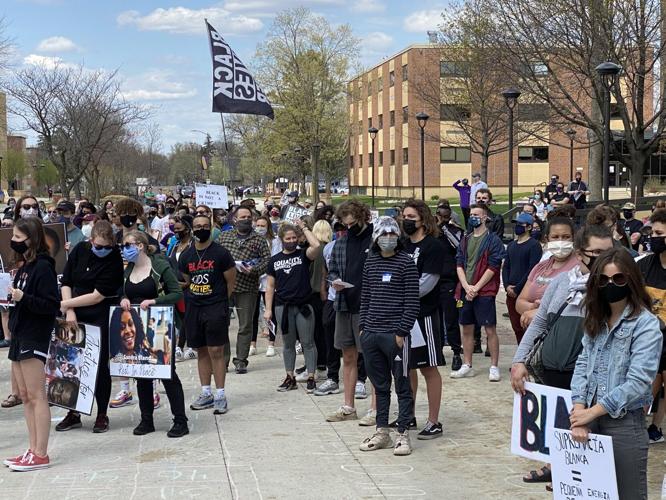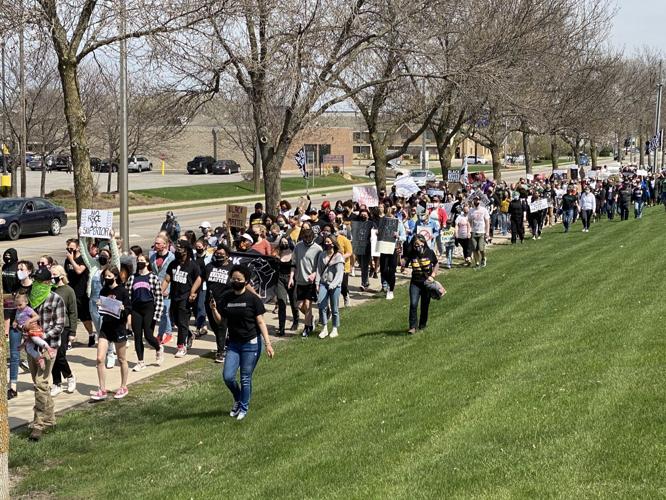MANKATO — The 400 or so people participating in Sunday’s rally against racism at Minnesota State University had a lot on their minds, from the death of another unarmed Black man at the hands of the police in Brooklyn Center, to racist stickers posted on MSU and Gustavus Adolphus College campuses a couple of weeks ago.
But what particularly irked many, including Henry Morris, vice president of Diversity and Inclusion at MSU, is the complacency and attempts to justify police violence by blaming the victims for their deaths.
“None of those things should be death warrants,” Morris said to the crowd gathered outside of MSU’s Centennial Student Union. “That’s the problem.”
Despite all his accomplishments, from multiple degrees to a well-paying and successful career, Morris, who is Black, still gets nervous when he sees police.
“When I get in my car, I’m still nervous if I see a police car behind me,” Morris said. “And there’s something wrong with that.”
Kenneth Reid, director of African American Affairs at MSU and one of the organizers for the March Against Anti-Semitism and White Supremacy, points to the increasing distrust people of color have in their interactions with police due to the continued violence.
“The simple fact that Daunte Wright didn’t’ feel safe enough to be arrested by the police officer speaks to a larger issue, which is knowing that our criminal justice system has not typically ruled in favor of people of color, or more specifically, Black folks.”
Ayan Musse, of Mankato, pointed out that 20-year-old Wright called his mother after he was pulled over, worried for his safety.
“You can never understand unless you’ve received or made that call: “Mom, I’ve been stopped. They want my insurance. There are two cops. One is holding a gun.”
“To my white allies, I know you’re trying,” Musse said. “We see you. Do not let us carry the pain alone.”
Musse challenged rally goers to do more than just talk, but to take action. She said that the focus on national laws and racist incidents in other states often eclipses the change that can happen on the local and state level.
“To all the women on this field, run for office,” she said. “And for the rest of us, support someone who wants to run. That’s how you give back; in order to dismantle the system of white supremacy, we really have to stand together.”

MSU students Makiyia Harvey (left) and Fatima Jalloh raised signs against complacency and to honor the Black and brown people killed at the hands of the police and other attacks across the country.
MSU student Taylahn Russ said she came to the rally to stand together with people of all backgrounds in the fight for justice.
“I’m half Black and my friends are down here fighting for me,” she said. “I’m fighting for myself and the people who look just like me.”
Julio Zelaya, a program coordinator with the American Civil Liberties Union in Mankato, one of the organizations sponsoring the event, said the goal of Sunday’s short march and rally was to give people space to grieve and to process the killing of Wright and the recent racist stickers posted around town.
“We’re trying to respond to those two incidents and also be conscious about what’s going on in our state,” he said.
Amy Vokal, director of the Mankato Department of Public Safety, said the racist propaganda posted around town and the MSU campus was taken down a little over a week ago and is a part of an effort by white supremacists to target college campuses across the U.S.
“This is something that’s been going on nationwide with this particular group,” Vokal said. “Moorhead had a similar incident three or four weeks ago. It’s been popping up on college campuses all over the country, and it’s from this very specific group not located in Minnesota.”

A driver raises his fist Sunday in solidarity with anti-racist marchers along Stadium Road.
But Ciree Cox, vice president of the Black Student Union at MSU, said the words of one or two people can’t drown out what she said is mostly an inclusive atmosphere on campus. She’s devoted the past three years as a college ambassador leading tours of the campus for potential students.
“I need to see more of you in leadership,” she said. “I did orientation for three years because I wanted Black parents to see my face and to know that it’s OK for your children to come here as a place where they can flourish.”
Morris acknowledged that while the university has moved in a positive direction in terms of equality for all students, there’s still a lot of work to do. On the community level, he thinks changing the law to prevent officers from pulling people over for minor infractions would be a good first step and may have prevented the killing of Wright.
“One of the biggest problems out there is these infamous traffic stops that are used to harass people of color,” he said. “And then from those stops, bad things happen. There are many ways in this day and age — if somebody has an expired license plate, take a picture and mail them a ticket — you don’t have to stop them. There don’t have to be six police cars.”
Reid said a lot of people don’t understand the trauma experienced by people of color that stems from being treated differently and having to witness a different system of justice for whites and people and color — from the war on drugs to the double standard of how people are treated by police.
While speaking to the crowd, he referred to the way police reacted much differently last week when a white Hutchinson man fled police in his vehicle, injuring an officer after assaulting a store employee over a mask mandate. Unlike Wright, he was unharmed when taken into custody.
“I’ve seen too many people who are out here doing some of the same things and are still alive,” Reid said. “I want my people to have that same due process in the criminal justice system.”





























Commented
Sorry, there are no recent results for popular commented articles.